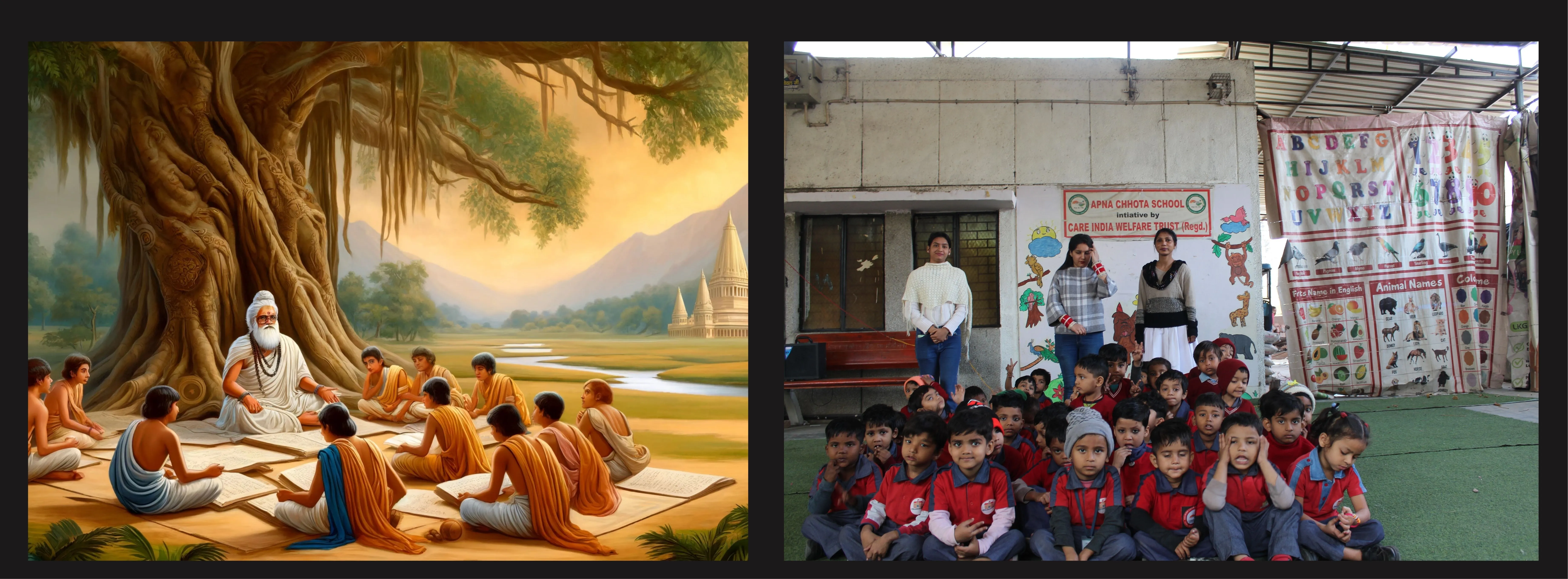Introduction
India's education system has always been the basis of the country's social progress. India has a fascinating story when it comes to education, spanning from the ancient gurukuls to its time under British rule and its modern schools. Looking into this growth trajectory not only traces the stage education has taken but also the impact of various reforms on the learning ecosystem.
Ancient education in India
The main educational system in India was based on gurukuls. Students received tutelage from their guru. The curriculum was centred around moral values, philosophy, mathematics, science, and literature. This system was the stage of development of higher education in India, with Nalanda and Takshashila becoming the institutions of universal education.
"Higher education would thus be the lifeblood of civilisations of the future," said Maharishi Chanakya, the father of education in India, along with other scholars. The number of people who could afford education was not very high, and it was available mostly to members of different communities, with some of them even having schools of their own. They all stressed the importance of free education in India.
English Education and Colonial Time
The introduction of English education to India is known as the Magna Carta of the educational system of India. Who was responsible for the introduction of English education into India? It was Lord Macaulay who, in the 19th century, prepared the way for English-medium education, the main idea behind which was to create an educated class that could handle administrative work under British rule.
In those days, women's education in India was only a few steps ahead, and it was hard to gain acceptance due to the prevalent social and cultural barriers. Among the reformers, Ishwar Chandra Vidyasagar and Jyotirao Phule are the two names who campaigned for the importance of women's education in India and that its importance was in the social development too.
Contemporary Education System
After gaining independence, India turned its attention to expanding access to primary education through programs such as the Right to Education in India. Along with the main theme of equal education for all, the government put equal gender and modern infrastructure at the core of its concerns. Now India is encouraging STEM education at all levels in order to prepare students for global technical challenges.
The digital and online education in India has changed the traditional ways of knowledge dissemination. Students at distant locations can take advantage of high-quality learning through distance education in India, hence overcoming the limitations of the region and solving the problem of lifelong learning access.
Higher and Professional Education
Higher education in India has witnessed exponential growth, with universities and institutes offering various programs. The attention is no longer on quantity but has shifted to research, innovation, and practical learning. The effects of the Goods and Services Tax on the education sector in India and the Education tax changes in India influence privately owned institutions, and online teaching courses are a reflection of the interconnectedness of education and economic policy.
Levels of education in India start with the primary stage and go up to the secondary and tertiary stages. They also include some forms of vocational training and professional courses. The different stages of education in India have led to the holistic development of individuals, thereby preparing them for the job market and responsible citizenship as well.
Visionary Leaders in Indian Education
Dr Sarvepalli Radhakrishnan, the father of modern education in India, used to tell that point very often that education is the key to national power and pride. The likes of Mahatma Gandhi and Rabindranath also were visionaries who taught methods of learning that had a holistic approach and that one had to grow morally, intellectually and creatively at the same time.
Women's Education in India
Still, gender disparities exist in the field, notwithstanding the achieved progress. The necessity of women's education promotion in India should be among the most important issues discussed, since educating girls is the most effective way to achieve gender equality, communal economic growth, and peace at the societal level. Programs contributing to women's education in India are the means that ensure the supporters' participation is fair and that the advancement is sustainable.
The Future of Education in India
The use of technology has become the main feature of the modern digital educational system in India. Through changes in online and personalised learning as well as global collaboration, India is ready to become a knowledge-based country. Measures aimed at giving free education and widening the scope of quality learning in India are the means through which the heritage of education from ancient Gurukuls to current classrooms is maintaining its evolutionary trend.
Conclusion
One cannot just go down memory lane without noticing how the educational system in India has evolved over the centuries. Gradually, the education system in India changed and migrated from the ancient gurukuls to schools, digital learning, and online education. At present, education in India is inclusive and creative, besides being technology-driven, which facilitates access at all levels of education in India. India is becoming a very knowledgeable, skilled, and empowered society by putting sustained focus on women’s education in India, STEM education in India, and quality higher education in India. Care India Welfare Trust is one of the organisations transforming India’s education landscape. It provides quality education, empowers women, and supports underprivileged children through impactful initiatives, paving the way for an inclusive, progressive, and brighter educational future for all through its dedicated social and educational efforts.
FAQs
Who was the first to emphasise the need for modern education in India?
The best-known advocate of modern education in India was Dr Sarvepalli Radhakrishnan, who promoted the idea of universal access to learning, the practice of spiritual growth, and the merging of Indian philosophy with present-day education.
What impact does women’s education have in India?
Educating women in India not only helps the community but also significantly lowers social disparities and accelerates economic growth. Apart from being the centre of household decision-making, the educated woman is involved in family health and children’s education, which are key reasons for advocating women’s education in India at every level.
What are the changes brought about by digital and online education in India?
The availability of digital and online education in India has made the learning process less restrictive and costly. The Indian online education revolution has made it possible for students sequestered in distant villages to pursue higher education, thus levelling the field and bridging the separating line present in traditional education systems.
Who introduced English education in India?
He was a British official who believed that teaching Indians in English would help them work for the British government. He wrote a famous speech called the "Minute on Education", where he said English should be used to teach subjects like science and math, instead of traditional Indian languages.

